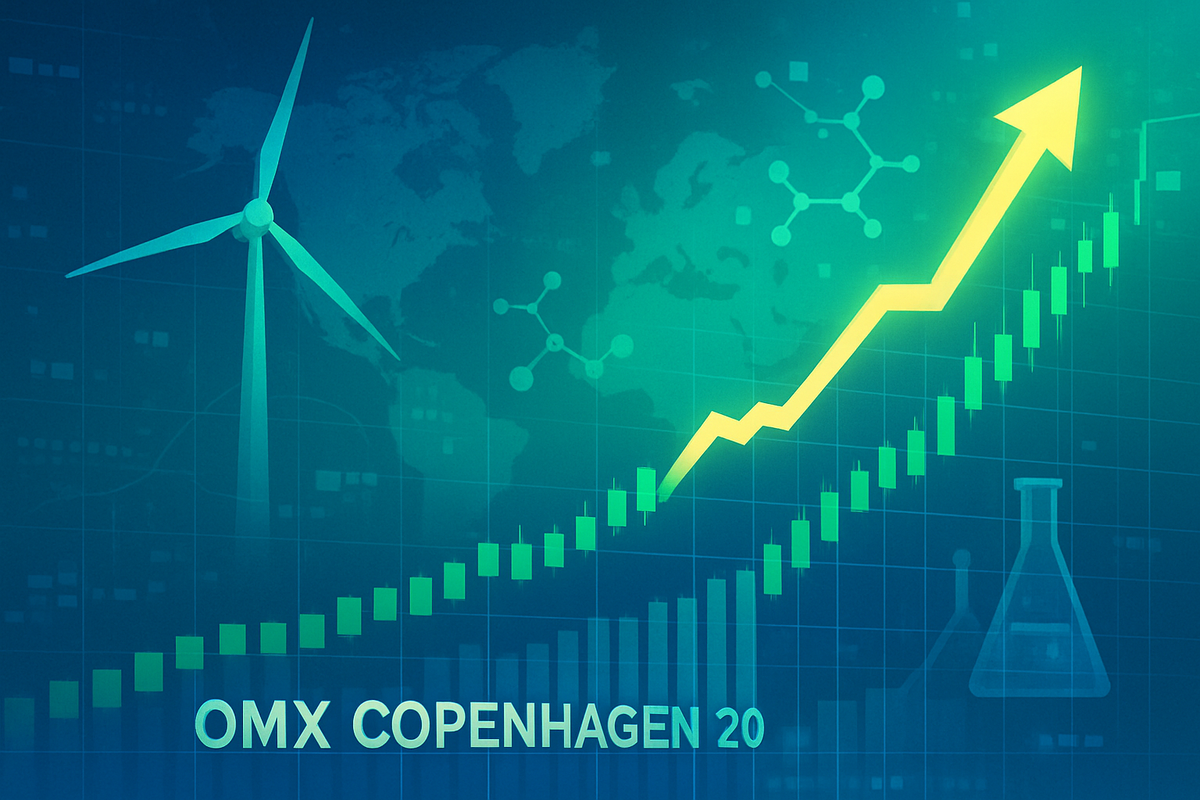
Copenhagen's stock market demonstrated robust performance in early October 2025, with the benchmark OMX Copenhagen 20 (OMXC20) index experiencing a significant uplift. While specific daily fluctuations are common, the period saw a notable surge, including a substantial 4.2% jump on October 1st, reflecting a broader wave of investor confidence across the Danish economy. This positive movement signals a bullish outlook for the nation's leading publicly traded companies and suggests underlying strength in key sectors.
The immediate implications of such an upward trend are multifaceted, ranging from a boost in investor morale and a potential wealth effect for those holding Danish equities to a more optimistic economic forecast for the country. A rising stock market often acts as a forward-looking indicator, suggesting that market participants anticipate healthy corporate earnings and sustained economic growth, making Denmark an attractive hub for capital.
Detailed Coverage: Unpacking the Market's Ascent
The recent buoyancy in Danish equities culminated in the OMX Copenhagen 20 (OMXC20) closing at 1,594.96 on October 2, 2025, building on a strong performance earlier in the week. This upward trajectory was significantly influenced by a confluence of positive factors, both domestic and international, painting a picture of a market gaining considerable momentum.
A primary catalyst for this impressive performance was the pharmaceutical behemoth Novo Nordisk (CPH: NOVO B). On October 1, 2025, the company's shares surged by 6.6% following an upgrade from HSBC, which revised its rating from "Hold" to "Buy." Given Novo Nordisk's considerable weighting within the OMXC20, its individual strong showing provided a substantial tailwind for the entire index, underscoring the company's pivotal role in the Danish market's health.
Beyond individual corporate successes, the Danish market also benefited from a broader positive sentiment permeating European and Nordic bourses. The OMX Nordic 40 Index, for instance, recorded a 2.0% increase on October 1, 2025, indicating a regional uplift. This widespread optimism was further bolstered by global market dynamics, including a tech-driven stock rally observed throughout the third quarter of 2025, which often has a positive spillover effect on smaller, open economies like Denmark. Furthermore, anticipation of additional interest rate cuts by the Federal Reserve, following an initial reduction in September 2024, contributed to a favorable environment for equities, as lower borrowing costs typically make stocks more appealing.
Companies in Focus: Navigating the Tides of Prosperity
The recent surge in the OMX Copenhagen 20 has not created a uniformly buoyant environment for all its constituents, though the prevailing sentiment is overwhelmingly positive. The impact is nuanced, with certain sectors and companies poised to reap greater benefits from the current economic tailwinds.
The Healthcare and Pharmaceutical sector stands out as a primary beneficiary, largely anchored by the colossal presence of Novo Nordisk (CPH: NOVO B). Despite a recent restructuring announcement in September 2025, aimed at redirecting savings into growth opportunities in diabetes and obesity research and development, the company's long-term outlook remains exceptionally strong, as evidenced by the HSBC upgrade. Other healthcare giants such as Coloplast (CPH: COLO B), a leader in ostomy and wound care, Genmab (CPH: GMAB), a biotechnology firm specializing in antibody therapeutics, and Demant (CPH: DEMANT), a prominent hearing aid manufacturer, are also well-positioned. These companies benefit from robust global demand for healthcare solutions, innovation-driven growth, and potentially easier access to capital for R&D due to lower interest rates. Similarly, Chr. Hansen Holding (CPH: CHR) in bioscience and Novozymes (CPH: NZYM B) (now Novonesis) in industrial enzymes are set to capitalize on increased demand for their specialized solutions.
The Financials sector, represented by Danske Bank (CPH: DANSKE) and insurance provider Tryg (CPH: TRYG), is expected to thrive amidst the anticipated Federal Reserve and Danish central bank rate cuts. Lower borrowing costs typically stimulate lending, mortgage activity, and business investments, directly boosting bank profitability. A strong and stable Danish economy, characterized by low unemployment and sound public finances, further reduces credit risk and fosters a healthy operating environment for these institutions.
Consumer Discretionary and Staples companies like Pandora (CPH: PNDORA), the global jewelry brand, Carlsberg (CPH: CARL B), the brewing giant, and Royal UNIBREW (CPH: RBREW), a leading beverage company, are also poised for gains. Increased real wages and robust consumer confidence, coupled with a positive domestic demand outlook, are expected to translate into higher private consumption and greater disposable income, directly benefiting these consumer-facing businesses.
Furthermore, Denmark's ambitious green agenda places Renewable Energy and Green Technology companies at the forefront of growth. Ørsted (CPH: ORSTED), a world leader in offshore wind power, and Vestas Wind Systems (CPH: VWS), a major wind turbine manufacturer, are strategically aligned with both national and global drives towards decarbonization. Substantial investments in renewable energy infrastructure and carbon capture technologies will provide significant opportunities for these players.
In the Industrials and Logistics sector, companies such as DSV (CPH: DSV), a global transport and logistics provider, and A.P. Møller - Mærsk (CPH: MAERSK A / MAERSK B), the shipping and logistics conglomerate, stand to benefit from increased economic activity and trade volumes. However, some uncertainties regarding global trade in services could introduce more nuanced growth for shipping compared to goods trade. Rockwool International (CPH: ROCK B), a manufacturer of stone wool insulation, will also see increased demand from heightened construction and infrastructure investments.
While the overall market sentiment is positive, companies heavily exposed to volatile global trade or intense international competition, particularly if not offset by unique product offerings or strong domestic demand, might experience more moderate gains compared to the top performers.
Wider Significance: Denmark's Market as a Microcosm of Global Trends
The robust performance of the Danish stock market in early October 2025, particularly the uplift in the OMX Copenhagen 20, transcends mere local market dynamics. It serves as a compelling microcosm of broader global industry trends, strategic corporate maneuvering, and the intricate interplay of regulatory pressures and economic forces. While the immediate rally showcased strong gains, a longer-term perspective reveals a more nuanced picture, with the Morningstar Denmark Index experiencing a downturn over the past year, largely due to the outsized influence of Novo Nordisk (CPH: NOVO B). This suggests the recent rally might be a significant rebound or an event-driven surge within a more volatile period.
At the heart of this market activity lies the pharmaceutical giant Novo Nordisk, whose strategic focus and promising drug pipeline, including CagriSema and oral semaglutide programs, continue to be a dominant force. The company's performance is deeply intertwined with broader pharmaceutical industry trends. These include the exponential impact of Artificial Intelligence (AI) in drug discovery, accelerating understanding of human biology through data-driven approaches, and a pervasive shift towards patient-centric and personalized medicine. Strategic activities like mergers and acquisitions (M&A) are also fueling innovation, as exemplified by Novo Nordisk's significant $2.2 billion deal with Septerna for cardiometabolic disease medicines.
However, this success also intensifies competition, particularly in the lucrative GLP-1 and obesity markets, where rivals like Eli Lilly (NYSE: LLY) and its drugs Mounjaro and Zepbound pose a significant challenge. This heightened rivalry drives increased R&D spending and strategic adjustments, impacting not only the pharmaceutical behemoths but also their biotech partners, such as Zealand Pharma (CPH: ZLDP), which also saw a stock jump during the rally, indicating positive sentiment spilling over.
Regulatory and policy implications are equally significant. The threat of 100% U.S. pharmaceutical tariffs, as signaled by former President Trump, has prompted companies like Novo Nordisk to strategically invest in U.S. manufacturing, potentially reshaping global supply chains. Domestically, new Danish legislation requiring critical medicine stockpiling, effective January 1, 2025, aims to prevent supply disruptions but could introduce increased costs for manufacturers. Furthermore, global drug pricing pressures and changes to advertising regulations in Denmark reflect a broader push for greater transparency and cost-effectiveness within the industry.
Historically, the concentration of market influence in a single company or sector is not unprecedented. From the Dutch East India Company to the "Original Magnificent Seven" in mid-20th century America (AT&T, General Motors, IBM, etc.), and more recently, the super-cap technology stocks, dominant players have often shaped national and global market trajectories. Novo Nordisk's substantial weighting in the OMXC20 (over 40% in some indices) places it firmly in this category, illustrating how a single entity's fortunes can profoundly impact an entire national market. Despite global uncertainties stemming from trade conflicts and geopolitical tensions, Denmark's robust economy, bolstered by strong pharmaceutical exports and prudent public finances, provides a resilient backdrop for these market movements.
What Comes Next: Navigating the Future Horizon
The Danish stock market, particularly the OMX Copenhagen 20, finds itself at a pivotal juncture in early October 2025. While a recent surge has instilled confidence, the path forward is shaped by both immediate catalysts and long-term structural shifts, requiring strategic agility from companies and vigilance from investors.
In the short term, the market is likely to continue benefiting from capital inflows, driven by the U.S. Federal Reserve's anticipated interest rate cuts. Lower U.S. rates tend to make Eurozone assets, including Danish equities, more attractive, potentially sustaining rallies, especially in interest-rate-sensitive sectors like real estate and utilities. However, this short-term optimism is tempered by the Danish central bank's moderated GDP growth forecasts for 2025 and 2026, signaling a more subdued economic expansion despite rising household purchasing power. Global trade conflicts and cautious consumer confidence remain headwinds.
Looking at the long term, Denmark's economic outlook remains robust, propelled by strong industrial production, particularly in the pharmaceutical sector, and renewed North Sea energy extraction. While the growth rate of the pharmaceutical sector is projected to moderate, and the working-age population is declining, the country's strong public finances and substantial savings surplus provide a solid foundation.
The omnipresent influence of Novo Nordisk (CPH: NOVO B) will continue to be a defining factor. Accounting for a significant portion of the OMXC20 and Denmark's GDP, its performance acts as a "double-edged sword." While its historic growth in diabetes and obesity care has propelled the index, recent volatility highlights the systemic risk of a single-stock-driven market. Novo Nordisk's ability to navigate competitive pressures, regulatory scrutiny, and supply chain challenges, particularly in the GLP-1 drug market against rivals like Eli Lilly (NYSE: LLY), will heavily dictate the OMXC20's trajectory. Analysts, however, remain largely optimistic about Novo Nordisk's long-term growth following its 2025 restructuring.
Strategic pivots and adaptations for Danish companies are paramount. Diversification of supply chains and export markets is crucial in an era of trade fragmentation and potential tariffs. Companies are increasingly adopting flexible, "layered planning" approaches to rapidly adapt to geopolitical shifts. Embracing digital transformation, AI, and machine learning is no longer optional, particularly in the financial and life sciences sectors. Integration of sustainability into core business practices is also critical, aligning with Denmark's ambitious climate goals and stakeholder expectations. Furthermore, investing in internal talent and robust corporate governance will be vital for sustained resilience.
Market opportunities abound in green technology and renewable energy, driven by Denmark's environmental targets and leadership in offshore wind. The life sciences and biotechnology sectors, beyond Novo Nordisk, continue to offer compelling investment avenues. The nation's high digital literacy and supportive regulatory framework also create significant opportunities in ICT and Fintech. After a challenging 2025, some Danish stocks may also present attractive valuations. Conversely, challenges include the persistent Novo Nordisk concentration risk, global trade tensions, geopolitical instability, and talent shortages in key sectors.
Potential scenarios range from an optimistic outcome of continued growth with diversification, driven by favorable global interest rate policies and successful corporate adaptations, to a pessimistic scenario involving a significant downturn. The latter could be triggered by unexpected setbacks for Novo Nordisk or a severe escalation of global trade wars impacting Danish exports and employment. A moderate scenario envisions steady but uneven growth, where Novo Nordisk remains a major driver, but its growth normalizes, and global trade tensions persist without severe escalation.
Ultimately, the future of the Danish stock market hinges on a delicate balance: Novo Nordisk's sustained innovation, the nuanced impact of global monetary policies, and the collective ability of Danish companies to strategically adapt to an increasingly complex and uncertain global environment.
Wrap-up: Denmark's Resilient Market in a Shifting Global Landscape
The recent uplift in the OMX Copenhagen 20 in early October 2025 underscores the inherent resilience and strategic positioning of the Danish stock market within a dynamic global financial ecosystem. While the immediate surge, significantly propelled by the pharmaceutical giant Novo Nordisk (CPH: NOVO B) and broader positive sentiment from anticipated Federal Reserve rate cuts, signals robust investor confidence, a comprehensive view reveals a market undergoing significant structural evolution. The key takeaway is that Denmark's market, though small, is a powerful bellwether for innovation in pharmaceuticals and green technology, deeply integrated into global economic currents.
Moving forward, the market's trajectory will largely be defined by a few critical factors. Novo Nordisk's sustained innovation and ability to navigate intense competition in the GLP-1 drug market, particularly from Eli Lilly (NYSE: LLY), will remain paramount given its outsized influence on the OMXC20. Beyond this single entity, the Danish economy's strength in industrial production, life sciences, and renewable energy provides a diversified foundation for growth, even as it faces global trade uncertainties and geopolitical headwinds. The strategic adaptations by Danish companies – focusing on supply chain resilience, technological adoption (AI, digital transformation), and sustainability integration – will be crucial for long-term prosperity.
The lasting impact of this period will likely be twofold: a reinforcement of Denmark's status as a hub for advanced healthcare and green energy, and a heightened awareness of the concentration risk inherent in a market heavily weighted by a single dominant player. The regulatory landscape, with its focus on financial sector robustness, fintech innovation, and ambitious sustainability targets, will continue to shape corporate strategies and investment flows.
For investors, the coming months demand careful observation. Key indicators to watch include Novo Nordisk's clinical trial outcomes, competitive landscape shifts, and production capacity expansions. Globally, the pace and extent of Federal Reserve rate cuts, alongside any escalation or de-escalation of global trade tensions, will directly impact capital flows and export-oriented Danish companies. Domestically, monitoring consumer confidence, real wage growth, and the successful implementation of green transition initiatives will provide insights into the underlying health of the Danish economy. While opportunities abound in innovative sectors, investors should remain mindful of the concentrated nature of the OMXC20 and diversify their portfolios accordingly.
This content is intended for informational purposes only and is not financial advice.





